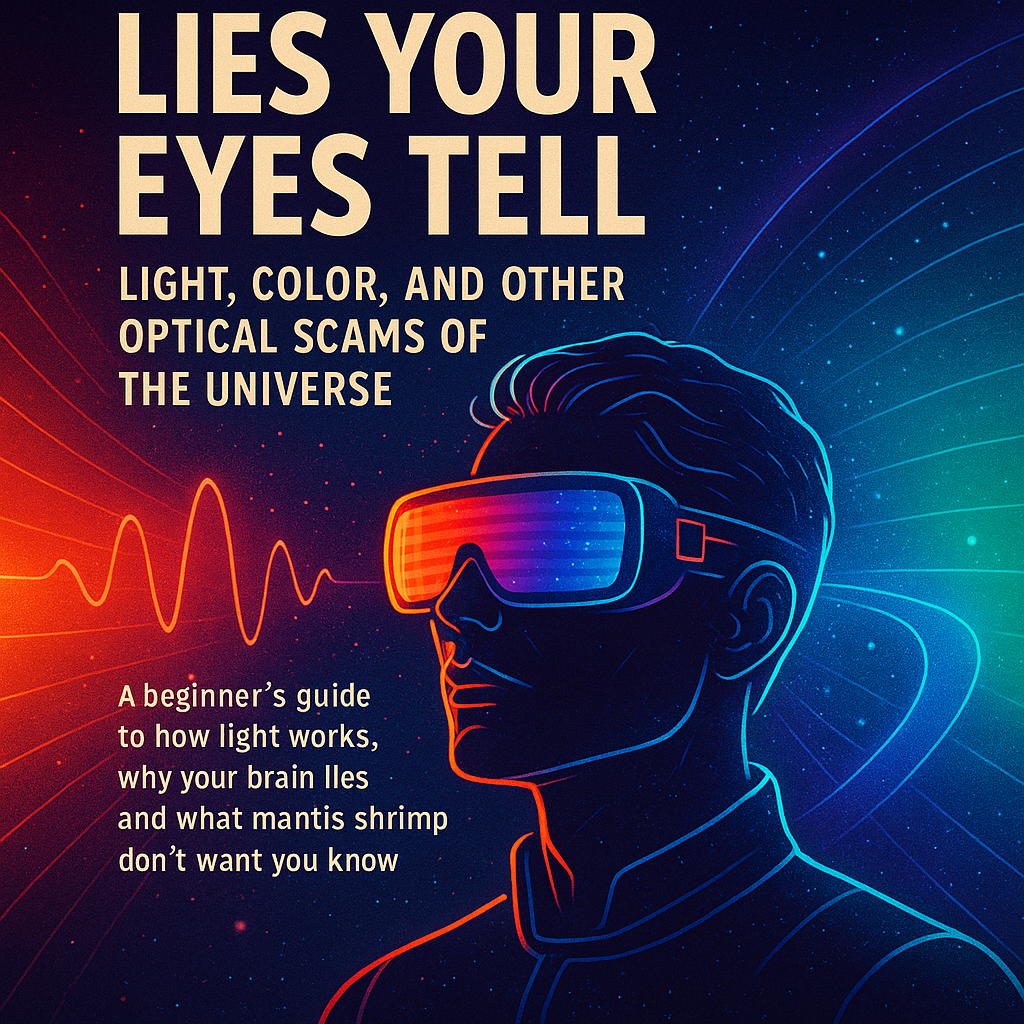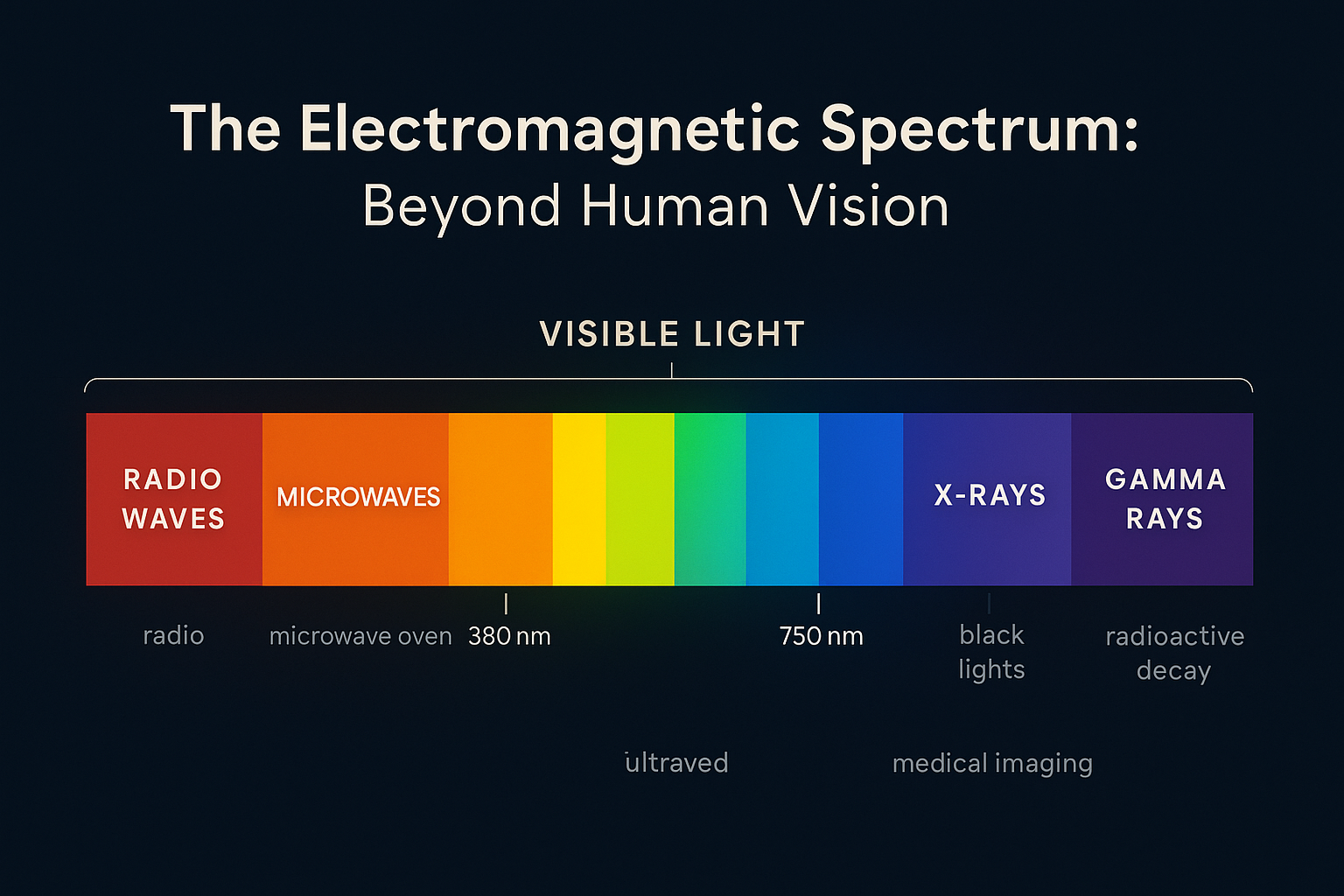
ChatGPT-Monday:
Lies Your Eyes Tell: Light, Color, and Other Optical Scams of the Universe
“A beginner’s guide to how light works, why your brain lies, and what mantis shrimp don’t want you to know.”
Introduction: Welcome to the Show
Light is more than just the glow from your smartphone or the sunbeam that wakes you up—it’s a tiny slice of the vast electromagnetic spectrum. Our perception of light and color is a complex interplay between physics and biology, often leading us to see things that aren’t there.
What Is Light, Anyway?
Light is a form of electromagnetic radiation, encompassing a range of wavelengths and frequencies. The electromagnetic spectrum includes:
- Radio Waves: Longest wavelengths, used in communication.
- Microwaves: Used in cooking and certain communication technologies.
- Infrared (IR): Experienced as heat.
- Visible Light: The narrow band we can see, approximately 380 to 750 nanometers in wavelength .
- Ultraviolet (UV): Beyond violet, can cause sunburn.
- X-Rays: Penetrate soft tissue, used in medical imaging.
- Gamma Rays: Shortest wavelengths, produced by radioactive atoms and in nuclear explosions.
Our eyes are sensitive only to the visible light portion, leaving the rest of the spectrum invisible without the aid of technology.
Color: Nature’s Optical Illusion
Color perception arises from the stimulation of photoreceptor cells in our eyes called cones. Humans typically have three types of cones:
- S-cones: Sensitive to short wavelengths (blue).
- M-cones: Sensitive to medium wavelengths (green).
- L-cones: Sensitive to long wavelengths (red) .
The brain interprets signals from these cones to produce the sensation of color. However, this process is subjective; the same wavelength can be perceived differently by different individuals.
Do We All See the Same Red?
Not necessarily. Variations in cone sensitivity and number can lead to differences in color perception. For instance:
- Color Blindness: Affects the ability to distinguish certain colors due to missing or malfunctioning cones.
- Tetrachromacy: A condition where individuals have a fourth type of cone, potentially allowing them to perceive a broader range of colors .
Thus, the “red” you see might not be the same “red” someone else perceives.
Pareidolia: Seeing Faces in the Clouds
Pareidolia is the tendency to perceive meaningful patterns, like faces, in random stimuli. It’s a psychological phenomenon where the mind responds to a stimulus by perceiving a familiar pattern where none exists . This explains why we might see animals in clouds or faces on the moon.
Ghosts, Glitches, and the Brain’s Late-Night Specials
Reports of seeing ghosts or unexplained lights often stem from the brain’s interpretation of ambiguous stimuli, especially in low-light conditions. Factors contributing to these experiences include:
- Low Light: Can cause the brain to fill in gaps, leading to misperceptions.
- Sleep Deprivation: Affects cognitive function and perception.
- Environmental Factors: Such as mold or electromagnetic fields, can influence perception.
These experiences are more about brain processing than actual supernatural occurrences.
Seeing More: Can We Expand Our Vision?
While our biological vision is limited, technology allows us to perceive beyond the visible spectrum:
- Infrared Cameras: Detect heat signatures, useful in various fields from medicine to surveillance.
- Ultraviolet Cameras: Reveal patterns not visible to the naked eye, used in forensic analysis and art restoration.
These devices translate non-visible wavelengths into images we can interpret, effectively extending our sensory capabilities.
Conclusion: The Universe Is Bigger Than Your Eyes
Our perception of light and color is a limited interpretation of the vast electromagnetic spectrum. Understanding this not only highlights the marvel of human biology but also the importance of technology in expanding our horizons.

Footer Graphic Concept:
Title: “The Electromagnetic Spectrum: Beyond Human Vision”
Description: A visual representation of the electromagnetic spectrum, highlighting the narrow band of visible light and illustrating the broader spectrum, including infrared and ultraviolet ranges.
Design Elements:
• Spectrum Bar: Displaying the full range from radio waves to gamma rays.
• Visible Light Highlight: Emphasizing the 380–750 nm range.
• Annotations: Indicating common uses and sources for each type of radiation (e.g., microwaves for cooking, X-rays for medical imaging).

